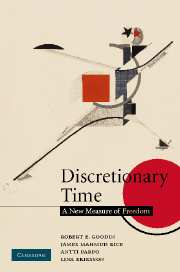Book contents
- Frontmatter
- Contents
- List of figures
- List of tables
- Preface
- Part I Introduction
- Part II Time pressure
- Part III Welfare regimes matter
- Part IV Gender regimes matter
- Part V Household regimes matter
- 13 How household regimes differ
- 14 The difference that household rules make
- 15 The difference that states make
- 16 Alternative household rules and temporal autonomy
- Part IV Conclusions
- Appendix 1 Methodology
- Appendix 2 Data
- Bibliography
- Index
14 - The difference that household rules make
Published online by Cambridge University Press: 28 October 2009
- Frontmatter
- Contents
- List of figures
- List of tables
- Preface
- Part I Introduction
- Part II Time pressure
- Part III Welfare regimes matter
- Part IV Gender regimes matter
- Part V Household regimes matter
- 13 How household regimes differ
- 14 The difference that household rules make
- 15 The difference that states make
- 16 Alternative household rules and temporal autonomy
- Part IV Conclusions
- Appendix 1 Methodology
- Appendix 2 Data
- Bibliography
- Index
Summary
In this chapter, we will probe the data we have been discussing to determine what difference people can make to their discretionary time through their own household's choices, by arranging their household on one set of rules rather than another.
The statistics we will be reporting in this chapter represent an average across all six countries under study. In the next chapter, we will turn to examine differences across these countries in what difference alternative household rules might make.
Preliminary methodological remarks
Up to this point in the book, whenever we have reported on discretionary time for people in certain household types, those reports have been based on the analysis of MTUS and LIS files for people who actually live in that type of household at present. Thus, in reporting the discretionary time available to single mothers in the US, for example, we have been reporting the mean amount of discretionary time among all women who actually are single mothers in the MTUS and LIS data sets for the US in the survey in question.
That style of analysis is invaluable for certain purposes but problematic for others. It is problematic, in particular, for answering the sorts of questions with which we are concerned in this part of the book. Next we shall essentially be asking (as we were in our ‘toy examples’ at the beginning of chapter 13) how people's discretionary time would change if they went from one sort of household to another – if a married mother became a lone mother, for example.
- Type
- Chapter
- Information
- Discretionary TimeA New Measure of Freedom, pp. 224 - 238Publisher: Cambridge University PressPrint publication year: 2008

